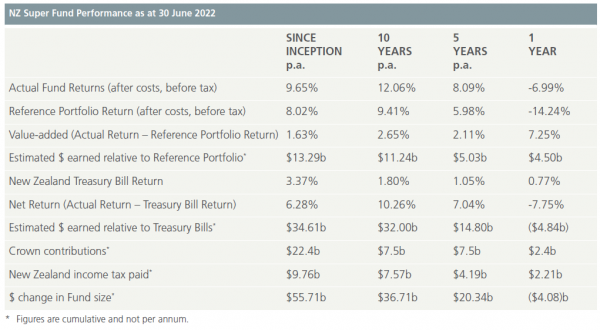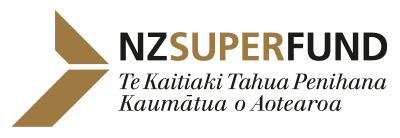Media statements
NZ Super Fund active strategies buffer difficult year in markets
POSTED ON: 12 September 2022
Share:
- As at 30 June 2022 the Fund stood at $55.7 billion, down from approximately $59 billion at the end of the previous financial year (-6.99%)*
- However, the Fund significantly out-performed its passive Reference Portfolio benchmark by 7.25%, generating a record $4.5 billion in value add – considerably reducing the impact of the broad market downturn
The downturn in global markets has seen the value of the NZ Super Fund reduce by $3.3 billion in the 12 months to 30 June 2022. However, a successful year for its active investment strategies cushioned the overall impact by delivering record value-added returns, says CEO Matt Whineray.
“It might sound counter-intuitive to say we had a strong year with the drop in value of the Fund,” says Mr Whineray.
“However, our active investment strategies have performed extremely well and are a reflection of the excellent work and skill of the team over many years.
The passively-invested Reference Portfolio, which sets the overall portfolio risk target and makes up approximately 60 percent of the Fund, returned -14.24 percent in the 2021/22 financial year. It is an index made up of 80 percent equities and 20 percent fixed income.
The Guardians’ active management saw the Fund significantly out-perform this passive Reference Portfolio benchmark by 7.25 percent, earning a record $4.5 billion in value add.
“This represents significant real value to New Zealand. While there is no hiding that market conditions are challenging – the first six months of 2022 have seen the worst global equity market performance since 1970 - the Fund showed resilience and is performing well,” says Mr Whineray.
As at 30 June 2022 the Fund stood at $55.7 billion, down from approximately $59 billion at the end of the previous financial year. Government contributions (net of NZ tax) since inception have been $12.6 billion.
In the last 10 years, the Fund has generated returns of more than 12 percent per annum.
Since investing began in 2003 the Fund has returned 9.65 percent per annum, equating to $34.6 billion more than the cost of Treasury Bills (what the Government would have saved if it simply paid down debt). The value added by active investment since inception represents $13.3 billion.
Mr Whineray credited the Guardians’ strategic tilting, timber, global macro, tactical credit and equity factors mandates with contributing to the strong value-add performance.
“Our Strategic Tilting strategy continues to perform above expectations and deliver strong value, with returns in 2021/22 largely driven by higher bond yields as central banks hiked interest rates in response to inflation.”
“Timber also continues to outperform, headlined by our investment in Kaingaroa Timberlands, a radiata pine forest in the central North Island of New Zealand.”
“Our global macro opportunity, a hedge fund strategy that bases its holdings primarily on the overall economic and political views of various countries or their macroeconomic principles, and our internally managed tactical credit mandate, also delivered strong returns. Tactical credit investments provide debt funding while using downside protection to mitigate or prevent a decrease in the value of an investment.”
“Equity factors investments in developed markets had a very strong year, reversing prior under-performance. Factor-based investing is a long-term strategy that uses a range of criteria – such as value, quality, momentum and low risk factors – in an effort to out-perform traditional equity benchmarks, while taking lower levels of risk. An allocation to the “value” factor, which had historically weighed negatively on performance, started to reverse in late 2021, after global equity markets began to pull back after reaching all-time highs.”
“The external economic environment continues to present challenges to investors. Heightened inflation, and the associated response by central banks to push up interest rates to suppress demand, places considerable pressure on investment returns for both bonds and equities,” says Mr Whineray.
“The periods of extraordinarily high returns, like 2020-2021 when the Fund returned 29 percent, are behind us. In effect we were bringing forward future returns in an environment which combined both monetary and fiscal stimulus.”
“Higher interest rates both weigh on market performance and increase our internal hurdles for making direct investments in companies. We believe we’re entering a lower return period, but remain confident our long-term approach will continue to deliver value to New Zealand.”
In the two months since the end of the 2022 financial year the size of the Fund has recovered by approximately $2 billion to $57.3 billion.
“We expect this market volatility to continue. Stakeholders should expect to see further ups and downs going forward. As a long-term investor the Fund is well-positioned for this sort of market,” says Mr Whineray.
*All figures are after costs and before New Zealand tax and are provided on a provisional, unaudited basis. The Guardians of New Zealand Superannuation 2021-2022 annual report and audited financial statements will be released in late October.
